If there’s one thing that makes living in South Korea relatively easy, it’s its accessibility and convenience. This extends to food as well; you will never have to go hungry simply because of their reliable food delivery services! Food delivery has become part and parcel of the lives of those who live in Korea, its popularity going beyond the home to reach offices, schools, parks and the like. This seemingly simple idea quickly developed into a multibillion-dollar industry (US$15.5 billion as of 2020), propelling the country to become one of the world’s largest delivery market.
If you’re wondering how the Korean food delivery culture came about, we’re here to let you privy to all the details.
Old History Of Food Delivery
Contrary to popular belief, food delivery is not a new invention introduced in recent years. The earliest Korean food delivery recorded was way back in the Joseon era (1392-1910), featuring cold buckwheat noodles in soup, otherwise known as 냉면 (naengmyun). It appears that this particular dish, which was greatly favoured by royalty, had gained popularity amongst noblemen, which later led to the start of delivery service. With the steady proliferation of the delivery service, various soups and noodles were later included in its menu, and it didn’t take long before 24-hour food delivery becomes commonplace.
The Favourite Late Night Snack
It’s not that difficult to guess Korean’s favourite delivery food. Move over 자장면 (jjajangmyun) and 탕수육 (tangsuyuk), it’s time to make space for fried chicken. Making up 20% – 30% of all orders on Baedalui Minjok, a food delivery app, it’s safe to say that fried chicken is enjoyed by Koreans of all ages. In fact, this beloved food is the number one delivery item on traditional holidays and national events such as major athletic matches.
But of course, the types of food delivered and consumed don’t limit to just fried chicken. In fact, traditional Korean food with rice, side dishes and soups, comes in a close second. Apart from traditional foods, many delivery apps serve any and every other kind of food you can name, from burgers, steaks, raw fish and even desserts. Satiating your cravings deep into the night has never been easier.
Convenience Is Key
The demand for food delivery has risen steadily over the years, and it doesn’t seem like it would stop anytime soon. There’s a simple reason why: convenience. Forget about heading over to the restaurant, spending time waiting in line and braving the crowd just to have a taste of your favourite foods – why do that when it’ll arrive right at your doorstep, piping hot?
Moreover, the entire process is pretty fast and secure. With a food delivery app, you can choose from the extensive menus and have the food of your choice be delivered to you. And since their services are fast and reliable, you can expect your food within minutes after placing your order!
Its rapid growth is also attributed to the changes in family structures. Most households do not have the typical nuclear family where one individual stay at home to cook and clean. These households are less likely to cook and more prone to order takeout, contributing to food delivery demand.
The food delivery culture is one small part that makes up the whole Korean culture. What better way to immerse in all that Korean culture and traditions have so much to offer if not learning the Korean language? Proficiency and fluency in the language will allow you to navigate through the culture and traditions with relative ease, allowing you to appreciate the culture and its nuances even more. Have a go and enrol in a Korean language course in Singapore to start the ball rolling.


